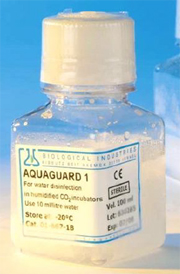BIODEGRADABLE DISINFECTANTS |
 |
FOR CELL CULTURE, MOL ECULAR BIOLOGY
LABORATORIES FOR VIRUS & MYCOPLASMA
PREVENTION. FOR BENCHES, INCUBATORS,
WATERBATHS AND OTHER WORK SURFACES
The term ’disinfection’ as denoted here refers to the destruction of potentially pathogenic microorganisms on inanimate objects. Disinfectants are basically chemical agents that are either lethal to microorganisms or inhibit their microbial activity and growth. Chemical disinfection plays a very crucial role, especially in the laboratory setting. Microorganisms, the cause of infectious diseases, are a heterogeneous group of organisms with a wide range of characteristics. With such a wide spectrum of biological characteristics, it is to be anticipated that particular groups of microorganisms or strains within a group will respond differently to the various means of disinfection. Disinfection is only one of the variegated measures that can be utilized to prevent and/or break the cycle of disease, but if used alone it is often adequate. Good hygiene and sanitation practices within the work setting are essential if the disinfection process is to be effective.
Some of the modes of action of disinfectants include: |
 |
- Adversely affecting the microbe's cellular physical structure by disruption
- of intermolecular interactions
Causing ensuing dissociation of the cellular bilayers Compromising cellular permeability and/or Inducing leakage of cellular contents by enzymatic dissociation Deactivation of other cellular metabolic processes.
|
| An understanding of the basic principles involving the disinfection process is essential to achieve a satisfactory outcome. The selection and use of any chemical disinfectant requires a detailed knowledge of such factors, such as: |
- Safety (i.e., potential hazards and toxicity) Range/spectrum of activity
- Ambient room temperature and humidity
- Type of surface
- Effectiveness in the presence of organic
- matter, lipids, fatty-acids and proteins
- Stability and reactivity
- Neutralization by pH changes
- Neutralization by soaps or detergents
Water hardness Contact time Specificity Environmental considerations
The aim of chemical disinfection is not to sterilize surfaces but rather to reduce the extent of microbial contamination to the lowest possible level. Most people utilizing disinfectants appreciate how essential it is to practice pristine hygiene and sanitation protocols, especially in a laboratory setting. Remember that disinfectants do not act instantaneously. Destruction of pathogens occurs in three phases: |
 |
- Initial/Lag Phase - When the disinfectant starts showing activity
- Median Phase - When the majority, but not all the microorganisms might be killed
- Final Phase - When the more resistant microorganisms are destroyed.
|
As a rule, allow the disinfection process the necessary time to optimize
|
its biocidal activity. |
| |
Biological Industries offers a variety of effective disinfectant agents. The best choice of product depends on the needs of the particular application |
| and includes the following products:Temp. |
| |
|
| Pharmacidal, spray bottle for disinfecting surfaces |
IC-110100
IC-110100-B |
1 liter
100ml
|
AMB
AMB |
Pharmacidal, for disinfecting surfaces
(without sprayer) |
IC-110100-G
IC-110100-L |
5 liter
250ml |
AMB
AMB |
|
Disinfectant solution for incubators and sterile benches in cell culture and molecular biology laboratories. The problem of contamination in incubators and/or sterile workbenches is often serious, leading to extensive damage. Pharmacidal solution prevents contamination, growth of fungi (and spores), bacteria (and spores) mycoplasma and viruses (including HIV and Hepatitis B).
The active ingredients are quaternary benzylammonium compounds, and the solution does not contain mercury, formaldehyde, phenol or alcohol. Furthermore, Pharmacidal is non-toxic and biodegradable. It has also been found to be fully compatible with common work surfaces.
|
| Recommended use |
- Spray incubators once every 2 weeks.
- Spray sterile benches once a day, or preferably before each laboratory worker begins using the work area.
- The surfaces to be disinfected should be completely wet by spraying. Allow to dry, no rinsing necessary.
|
Aquaguard-1 |
| Product Name |
Catalogue No. |
Unit Size |
Storage Temp. |
|
| AQUAGUARD-1 Solution for disinfecting water baths of CO2 incubators |
01-867-1B |
100ml |
-20ºC |
|
100ml of 100X concentrated solution for disinfecting CO2 water baths.
(Use 50ml per 5 liters of water in bath).
The water required for humidity is a source of contamination that disperses in the incubator. In order to disinfect the water we recommend Aquaguard-1 Solution, which contains a disinfectant that does not cause damage to the stainless steel tray, is non-toxic, non-volatile, and extremely effective. The water should be replaced with sterile water every two to four weeks, adding 50ml of Aquaguard-1 per 5 liters of water.
Preventive treatment as described above will prevent damage that can be caused as a result of contamination to the tissue culture. In addition, it will also prevent the necessity of dealing with contamination that has dispersed in the incubator and causes repeated contamination of the tissue culture.
|
 |
Aquaguard-2 |
| Product Name |
Catalogue No. |
Unit Size |
Storage Temp. |
|
| AQUAGUARD-2 Solution for disinfecting ordinary water baths |
01-916-1E |
50ml |
-20ºC |
|
50ml of 500X concentrated solution for prevention of microbial growth in water baths. (Use 2ml per 1 liter of water).
Aquaguard-2 is intended for disinfecting various kinds of water baths from bacteria and fungi. It is recommended to use 2ml of Aquaguard-2 for each liter of water in the bath, and to repeat the procedure every 1-2 weeks. After 4-6 weeks, the bath should be emptied and refilled with water containing Aquaguard-2. |
| |
